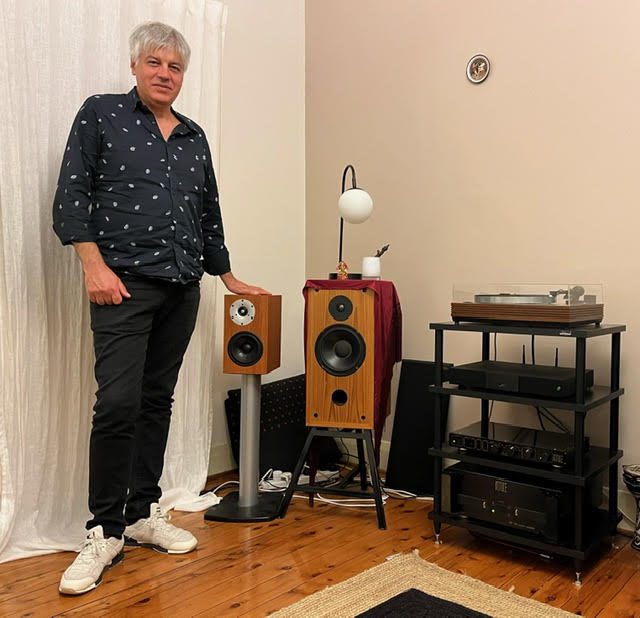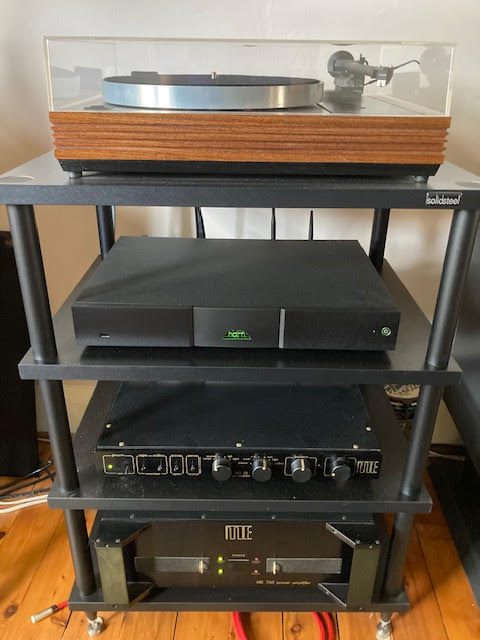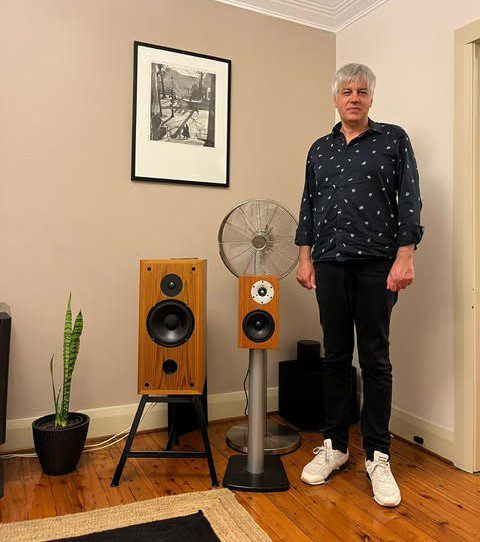
For a complete list of Nick’s system, see below.
“Hope you won’t laugh at my Aussie accent!” Nick emailed me after we’d made plans for me to interview him for this instalment. I promised him I wouldn’t, as long as he didn’t speak too quickly. It turned out that Nick was easy to understand, not only because the Australian accent in general isn’t as pronounced as other accents, say, from parts of the UK, but because we, as audio enthusiasts, speak another common language that is unaffected by accents—audio.
I’m always amazed by how alike we are as hobbyists, regardless of where we’re from in the world. We practice it the same way, and are open-minded about it in the same way. We understand that it’s a personal journey, but also that we’re in it together. We’re like siblings from another life sharing the same sandbox.
That spirit was proven again when I spoke with my new brother Nick from Sidney, Australia. Was an Australian hobbyist’s audio beginnings similar to those I’ve heard from other hobbyists around the world? Of course! We all started from humble beginnings, with mainstream audio, before we diverged from friends and turned into audio butterflies.

Nick’s earliest audio memory was of his parents’ record player. It had a tall spindle on which you could stack a handful of records on top of each other that would drop automatically one after the other once the previous record side had finished. “During parties, especially the ones with Greek dancing,” Nick said during our Zoom chat. “My father would tie a matchbox on top of the tonearm with an elastic band to weigh it down so the needle wouldn’t jump!”
The first audio product Nick owned was a ghetto blaster, given to him by his father on his 13th birthday. “That’s when I discovered serious music,” he said. “Led Zeppelin, Jimi Hendrix, The Who, Rolling Stones, the Beatles, that typical young boy stuff. From there, I went to Joni Mitchell, my favourite Canadian—I hate to tell you this, Robert, but you’re my 2nd favourite Canadian.” “That’s okay,” I muttered, looking at my watch. He continued: “I was 26 years old when I started buying high-end equipment.”
I asked what made him take the plunge. “I wanted a proper stereo,” he said. “I’d been putting it off because I didn’t have the money. When it finally started coming in, I bought my first system—an entry level one—but I wasn’t content with the quality, so I kept upgrading.
“At the same time, I was learning about the hobby. Looking back, the key to great sound is not rushing into things because compatibility is such an important thing in hi-fi and that can take time to figure out. Some things simply don’t work together as well as others. That’s what confused me at the outset when some equipment sounded so good in one showroom and bland and unremarkable in another.
“And Australia—I just saw Nick Cave and feel the urge to fly the Australian flag—punches above its weight when it comes to HiFi manufacturing. Among my components are an ME (Modular Electronics) preamplifier and ME amplifier. ME is a big part of Australian HiFi history, and in some ways Australia’s answer to Krell—they’re very muscular; they open up the soundstage; they have an effortless ability to let the music through. Sadly, the man who designed these products, Peter Stein, passed away and the company is no longer in business. His amplifiers are still highly sought after on the second-hand market.
“Also Australian are my Orpheus Dolomite speakers designed by erstwhile Orpheus owner Brad Serhan, whose speakers are used by the ABC, Australia’s version of Britain’s BBC. The Dolomites were Orpheus’s signature model. Many speakers are great for classical music, or funk, or rock, but aren’t able to deal with everything. Throw anything at the Dolomites and they will handle it well. I’ve kept them for a long time. They are a part of the soundtrack to my life.

“So impressed was I by Serhan’s speakers that I bought another of his models, this one under the new company he co-owns, Serhan Swift, which has a number of speakers out. I bought the Mu2 model, which are the best bookshelf speakers I’ve heard, in any price range. They retail for AU$ 7500/pair (CA$ 6800, US$ 5000) and are about to be made available in North America. It’s amazing how a speaker that small can make such an enormous sound. I find them revolutionary. So, to the audiophile audience, I highly suggest that you look into the Mu2 speaker. It’s a revelation.*

“I also own a Linn Sondek LP12 turntable,” he said. “This might outrage some of the purists, but I listen now much more to digital. Vinyl sounds a bit more organic and engaging, but I’m in my 50s now and I’m getting sick and tired of flipping over an LP every 20 minutes.
“I prefer to use my Naim ND5 XS 2 streamer. I thought my ME amplification sounded a touch clinical, and what I liked about the Naim streamer is that it sounds a bit more musical to me and it fits really well with the ME. I’m very happy with it.
“You asked other people you interviewed for this series if they had any hobbyist regrets. Well, if I had the chance to redo something, it would have been to spend less on the analogue front-end and more on the digital one. Had I done so, I would’ve gone with the model up from the ND5 XS 2—the NDX 2. It’s upgradable and you can use it with an external power source. But I’m still extremely happy with the ND5 XS 2. It was a huge step-up from my previous Musical Fidelity M1 DAC and laptop setup. I recommend to anyone looking for a streamer to put Naim on their short list.
“Digital has improved quite dramatically since it first came out,” he continued. “And hopefully it’ll soon be able to match that level of engagement we’re getting from vinyl.
“Another thing is my musical tastes changed. I gave a lot of my records to friends because I wasn’t playing them. So, as my record collection got smaller, I decided that rather than buy new records, I would put my money on the rest of the system.”
Did he know of any great tweaks?
“There’s a company here called Les Davis Audio. The owner, Les, designs vibration control products that use this sort of constrained layering damping technology to reduce vibrations and colourations. The technology is quite extraordinary and cost effective. I couldn’t believe how much of an uplift it brought to my system’s sound quality. I urge everyone to look into it.
“Those are my two biggest recommendations, really, the Mu2 speakers and, for an affordable tweak that really works, the Les Davis damping technology.”

Had he reached a point in his system’s performance where he didn’t feel the need to upgrade?
“Almost,” he said. “Next step will be to get the proper stands for the Mu2s.”
I asked what he liked about the sound of his system.
“It’s holographic. I close my eyes and can feel the sound of my system around me, like there’s a soft breeze running through everything. That is the ultimate, when you’ve hit the nirvana stage, when it’s reached that open soundstage where you close your eyes and feel the musicians are in the room with you.”
What did he like best about the hobby?
“Listening to music on it feels like an escape from the craziness of the world. It’s my meditation.”
Any advice for readers?
“Try to enjoy the journey rather than seek audio nirvana right away. Be in the moment and enjoy what you have. There is so much you can do to fine tune your sound. Speaker placement is incredibly important and no doubt the acoustics of the room itself can be improved.”
He continued: “If you have people telling you, ‘This is the best, that’s the best’, block that out, put on the music, close your eyes, and listen. Are you enjoying the music? That’s what it’s all about. And it has little to do with price. You can get a beautiful-sounding system for $5000 if you know how to put it together properly or get good advice in how to do so.
“From the top of my head,” he said. “I know a guy who’s got a system that cost over 2½ times what mine cost, and it sounds nowhere near as good as mine because that person didn’t put it together properly. He didn’t do his homework and he didn’t listen.”
*Nick has confirmed with me that he does not have business interests in any of the companies he recommends in this article.
Price list in CA$ unless otherwise indicated:
- Linn Sondek LP12 turntable ($6175) / Akito arm ($2500) / Sumiko Rainier MM cartridge ($210)
- Naim ND5 XS 2 streamer ($5199)
- ME 25 Preamplifier (Discontinued)
- ME 750 power amplifier (Discontinued)
- Orpheus Dolomite speakers (Discontinued)
- Serhan Swift Mu2 bookshelf speakers (AU$ 7500/pair)
- Inakustik and QED cabling ($various)
- Solidsteel stands ($various)
If you have a system you’d like to talk about in our “No, I have the best system in the world!” series, let us know by dropping us a line here.









Leave a Reply